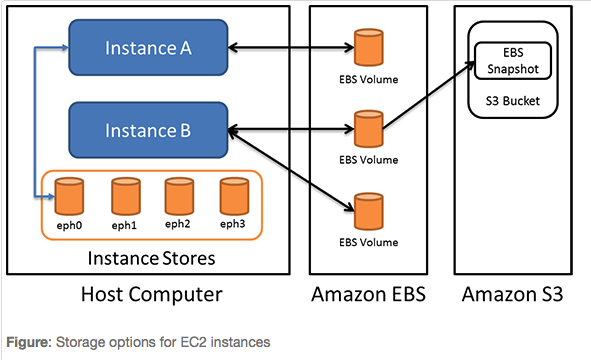Amazon Web Services (AWS)
the most popular cloud computing provider and is widely credited with the introduction of innovative concepts in cloud computing.
Elastic Compute Cloud (EC2)
Amazon Elastic Compute Cloud (Amazon EC2) is a service in AWS that provides resizable computing capacity in the AWS cloud. Amazon EC2 makes virtual servers (also known as instances) available to you as a service, thereby eliminating your need to invest in hardware up front and enabling you to develop and deploy applications faster.
EC2 Instance:
EC2 instances are virtual servers that you can configure and launch on Amazon EC2.
Instances have many parameters including:
Amazon Machine Image (AMI):
Is a template that contains a complete software image (operating system, applications, libraries and data). You launch instances using specific AMIs, which are copies of the AMI running as virtual servers in the cloud. You can launch multiple instances of an AMI.
Instance Type
Amazon offers different instance types which have varying amounts of compute and storage available to them. They range from t1.micro to cc2.8xlarge and have different on-demand/reserved and spot prices.
Regions and Availability Zones
Instances can be launched across various AWS regions, which are distributed geographically (Virginia/Singapore etc.). This allows users to spawn instances in the same region but across availability zones and protect applications from the potential failure of a single availability zone.
Pricing
Instances can be launched using three different pricing models:
Spot Instances
Spot instances are special instances which allow users to bid for unused computing capacity. You can specify an hourly rate that you are willing to pay to use an instance. In addition, for each instance type under each availability zone, Amazon maintains a spot price which reflects the current demand for the instance type. If your bidding price is more than the spot price, an instance will be launched at the current spot price and will continue to run until the spot price exceeds your bid price. Spot instances are volatile but very useful for getting instances for a few hours at prices that are typically much lower than the on-demand prices.
Instance Limits
AWS has preset limits on the number of simultaneous instances, per instance type, that an account can provision.
Managing Security Groups
Instances launched on EC2 are publically accessible using their Public DNS address. In order to better secure instances, EC2 opens only port 22 by default. This is controlled using Security Group definitions in the EC2 Dashboard. You can configure inbound and outbound ports and destinations.
Login EC2
For Ubuntu instances:
chmod 600 ec2-keypair.pem
ssh -i ec2-keypair.pem [email protected]
For other instances, you might have to use ec2-user instead of ubuntu.
Amazon EC2 Storage

Amazon EC2 Instance Store:
Instance stores are storage volumes that are present on the
hostcomputer that the instances are running on. Instance stores are temporary (ephemeral), block level storage. Instance store data is cleared when an instance is stopped or terminated.
Amazon Elastic Block Store (EBS):
EBS is a SAN-style
storage systemthat can be used with EC2 instances. EBS presents volumes to the user that can be created independently of an instance and attached to instances as needed. EBS volumes are persistent and flexible. Multiple EBS volumes can be attached to an instance, and an EBS volume can be detached from an instance and attached to another. EBS incurs additional charges (GB/month) over and above EC2 instance charges. EBS volumes can also be backed up by creating a snapshot, which is stored in Amazon S3.
Amazon Simple Storage Service (S3):
Amazon S3 is an object storage service which has a web services
interfaceto store and retrieve data. Instances can access data directly on S3 using the web services interface. Amazon S3 is also used to store snapshots of EBS volumes.
Simple Storage Service (S3)
Amazon S3 provides interfaces to write, read, and delete files (also known as objects in Amazon’s parlance) of sizes 1 byte to 5 terabytes of data each. The number of objects that you can store is unlimited. Each object is stored in a bucket and retrieved via a unique, developer-assigned key.